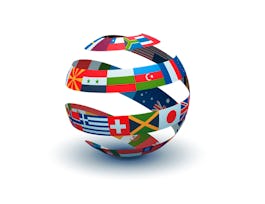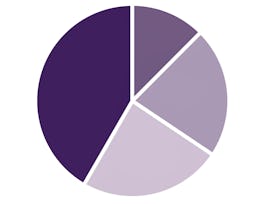In this course, you’ll learn to analyze rapidly changing global trends, their effects on consumer and labor markets, financial systems, and geopolitical relationships among countries all over the world. Professor Mauro Guillen of the Wharton School has designed this course to help you understand the magnitude of influence these trends have on the business world and society. Through real-world case studies, both historical and contemporary, you’ll examine how changes within one society affect others. By the end of this course, you’ll have gained the tools to be able to identify, analyze, and adapt to global changes as they affect your business and society.



Global Trends for Business and Society
This course is part of Business Strategies for A Better World Specialization

Instructor: Mauro Guillen
Sponsored by FutureX
18,414 already enrolled
(912 reviews)
Skills you'll gain
Details to know

Add to your LinkedIn profile
4 assignments
See how employees at top companies are mastering in-demand skills

Build your subject-matter expertise
- Learn new concepts from industry experts
- Gain a foundational understanding of a subject or tool
- Develop job-relevant skills with hands-on projects
- Earn a shareable career certificate


Earn a career certificate
Add this credential to your LinkedIn profile, resume, or CV
Share it on social media and in your performance review

There are 4 modules in this course
In this module, we’ll begin by examining the relationship between population size and density to the geopolitical balance of power in the world. You’ll learn key aspects of demographics (such as total fertility and life expectancy at birth) and how rapid demographic growth or decline affects global economic and geopolitical dynamics. Then, you’ll evaluate the economic and political impact of urbanization and migration within societies, and the consequences of these changes in population dynamics, both within a society and between countries. By the end of this module, you’ll have a richer understanding of the impact of demographic trends on financial markets, political systems, culture, and society.
What's included
9 videos3 readings1 assignment
This module was designed to give you a deeper understanding of how monetary trends and the distribution of monetary wealth affect the globe. Through close examination of global poverty and income inequality, you’ll learn critical concepts such as the Gini Coefficient and the Kuznets Curve, and how to use them as tools in analyzing the global distribution of wealth. You’ll also explore the rise of the global middle class, and how businesses are responding to the growth of middle class consumption. Finally, you’ll investigate the relationship between changing gender dynamics and wealth in the world. By the end of this module, you’ll be able to use effective analytical tools to form a clearer understanding of the effect of wealth within society and how it affects your organization.
What's included
6 videos2 readings1 assignment
In this module, you’ll examine the growing issue of global economic and financial imbalances. Through relevant examples such as the European Zone crisis, you’ll gain a deeper understanding of the effects of global economic dynamics on both individual countries and their relationships with one another. You’ll explore trade bloc controversies, different types of monetary unions (such as the European Union), and how financial imbalances affect the geopolitical balance and global economy. By the end of this module, you’ll be able to better assess the consequences of economic and financial imbalances on nations, markets, and societies, and be prepared to respond to these phenomena while making decisions for your organization and society.
What's included
8 videos2 readings1 assignment
In this module, you’ll explore global geopolitical landscapes and the global powers of the 21st century. Through examination of different political regimes—from autocracies to democracies—you’ll discover effective roles for states to play in society and its economy. You’ll also learn about failed states and anocracies, two importance sources of instability in the world, and how such instabilities manifest frictions and conflicts in the form of war and terrorism. Through analyzing the evolution of political regimes and failed states, you’ll learn the definition of global powers, the difference between and hard and soft power resources, and whether emerging global powers will cause dramatic changes in the existing geopolitical power structure. By the end of this module, you’ll have a deeper understanding of the trajectories of global powers, and be able to assess how the changes in geopolitical power structure will affect your business and society.
What's included
11 videos4 readings1 assignment
Instructor

Offered by
Why people choose Coursera for their career




Learner reviews
912 reviews
- 5 stars
82.34%
- 4 stars
14.58%
- 3 stars
2.41%
- 2 stars
0.21%
- 1 star
0.43%
Showing 3 of 912
Reviewed on Dec 19, 2017
Very well structured course and the coverage of the topic has been systematic and progressive such that one is able to link all the elements well.
Reviewed on Jun 8, 2020
Absolutely fascinating. Provided me with the fundamentals of assessing global patterns and trends to make informed hypotheses on the direction the world is taking.
Reviewed on May 15, 2018
The course gives a good and critical overview of the biggest global trends of the last, and the coming decade. It solidified my knowledge about geo politics, and also learned a lot.
Recommended if you're interested in Social Sciences

University of Virginia

University of London

Yunus Social Business Fund Bengaluru

University of Michigan

Open new doors with Coursera Plus
Unlimited access to 10,000+ world-class courses, hands-on projects, and job-ready certificate programs - all included in your subscription
Advance your career with an online degree
Earn a degree from world-class universities - 100% online
Join over 3,400 global companies that choose Coursera for Business
Upskill your employees to excel in the digital economy


